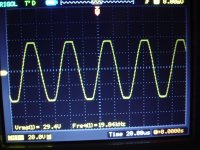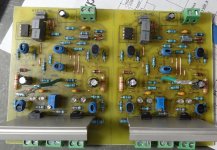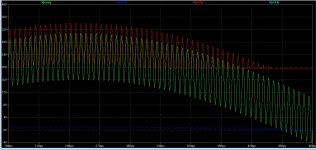The [clipping waveform] in post # 34 is horrible, by comparison. Of course this is only at 1kHz - the real deal is what happens at 10kHz ;-)
The antisaturation clamp diode approach in Bob Cordell's 35 year old AES paper on his power amp (link), comprising D5, D6, Q18, Q19, works very well in a wide variety of amplifiers ... including folded cascode "one gain stage" power amps. They clip (and recover from clipping) quite beautifully, even at 100 kHz. 10 kHz clipping? Pfffft. The Cordell template gives you the opportunity to experiment with better-than-1N4148 diodes for superb clamping, such as the ones that Giovanni Stochino employed in his 300V/usec power amp.
_
Attachments
Last edited:
I'm using FDH300 diodes for clamping, generally, because the leakage current when off is extremely small, order of magnitude less than run of the mill 1N4148 diodes.
Another option that could work very well for even less leakage is JFET as diode (gate to (drain & source connected)). The PN4401 IIRC is very good and inexpensive.
Jan
Another option that could work very well for even less leakage is JFET as diode (gate to (drain & source connected)). The PN4401 IIRC is very good and inexpensive.
Jan
Good for newbie's , why ohh why - is everyone bogged down with the
"blameless". It was the first that I built and sparked further reading
and progress.
Trying to move solid state into new and better stuff (below)
20khz clipping , even 200khz clipping is effortless (and saturation free).
I would of thought the 5th edition and on would of advanced to
what is now available. This forum is the greatest book on the
present state of SS amplification.
Amp in the picture blinks the cascode led's on overload. I have another
that uses a infrared opto (with the other 3 just IR) to average the overload(s)
right at the cascode. Too much and it triggers a SS relay to either cut off
the speakers , or it could even attenuate the input.
OS
"blameless". It was the first that I built and sparked further reading
and progress.
Trying to move solid state into new and better stuff (below)
20khz clipping , even 200khz clipping is effortless (and saturation free).
I would of thought the 5th edition and on would of advanced to
what is now available. This forum is the greatest book on the
present state of SS amplification.
Amp in the picture blinks the cascode led's on overload. I have another
that uses a infrared opto (with the other 3 just IR) to average the overload(s)
right at the cascode. Too much and it triggers a SS relay to either cut off
the speakers , or it could even attenuate the input.
OS
Attachments
Last edited:
What a badly designed audio power amplifier in the video of post #34. It is ill-behaved during clipping and creates tweeter-killing ultra high frequency spikes on the output. Ugh.
_
Sometimes we do this as a reference.
A bad design or even an outright failure is the best teacher.
Letting out "magic smoke" on occasion is what we do.
It's fun to blow a sanken mt-200 up.
Exploring a failure is very useful.
OS
What a badly designed audio power amplifier in the video of post #34. It is ill-behaved during clipping and creates tweeter-killing ultra high frequency spikes on the output. Ugh.
_
Niiiice
I use BAS21J for anti-saturation diodes. Fast (50ns) and low capacitance (<2pF)
BAS21 is the recommended DIYA honey badger clamp.
Adds about 2-3ppm to the mix.
But if it saves components/tweeters , worth it.
Edit - it's low capacitance also makes it good for my class H tracker circuit.
An example where one designs shortcoming teaches one how to improve
another design.
I would still prefer to not have this issue to begin with.
OS
Adds about 2-3ppm to the mix.
But if it saves components/tweeters , worth it.
Edit - it's low capacitance also makes it good for my class H tracker circuit.
An example where one designs shortcoming teaches one how to improve
another design.
I would still prefer to not have this issue to begin with.
OS
Last edited:
You can never escape saturation and storage time if the transistor base is overdriven which is going to happen in the real world. Another option would be to clamp the input signal as the amplifier output starts to clip - I think Bob Cordell did something like this (Klever Klipper?) but for the penny or so you pay for a BAS21J, I think its a good all-round solution.
On low loop gain amps, you don't normally get this problem - eg the class A sx-Amp clips very softly - kind of like tube amp, but the kx-Amp, which has a moderately high loop gain does not clip cleanly without anti-sat diodes (I used 4148 for DIY ease of use in that one).
BTW, some of the earlier op-amps did not behave well when overdriven - on some the output inverted, there were serious recovery problems on others (LF35X family for example) - so this is not just a audio amp or DIY problem.
On low loop gain amps, you don't normally get this problem - eg the class A sx-Amp clips very softly - kind of like tube amp, but the kx-Amp, which has a moderately high loop gain does not clip cleanly without anti-sat diodes (I used 4148 for DIY ease of use in that one).
BTW, some of the earlier op-amps did not behave well when overdriven - on some the output inverted, there were serious recovery problems on others (LF35X family for example) - so this is not just a audio amp or DIY problem.
Last edited:
Yep if you clamp every high swing collector such that the collector never falls below the base, Vcb>0, you'll never saturate. Cordell's idea to use emitter followers to provide clamp "supplies" (Q18-19) ensures plenty good and plenty low impedance on the constant voltage end of the clamp diodes.
Jan, the FDH300 looks quite good. For JFET gate-to-source diodes that are still in production today I think you'd probably choose one of the selected low leakage devices from Linear Systems: 1 picoamps!
4401 is an NPN bipolar.
Jan, the FDH300 looks quite good. For JFET gate-to-source diodes that are still in production today I think you'd probably choose one of the selected low leakage devices from Linear Systems: 1 picoamps!
4401 is an NPN bipolar.
eg the class A sx-Amp clips very softly - kind of like tube amp
Your amps got me interested in symmetrical designs.
I have overdriven these type amps and analyzed the distortion products.
Even order (all 2nd , little bit of 4th) - just like a tube.
The "valve" and class A audiophiles don't believe it. But we really HAVE
truly faked their "tube sound" with solid state.
OS
This is clipping of my very simple 120W CFA design with lateral OPS. It does not use any clamp diode, just IPS clips nicely by itself.
Schematic post before.
https://www.diyaudio.com/forums/solid-state/243481-200w-mosfet-cfa-amp-118.html#post5299551
Schematic post before.
https://www.diyaudio.com/forums/solid-state/243481-200w-mosfet-cfa-amp-118.html#post5299551
Last edited:
Jan, the FDH300 looks quite good. For JFET gate-to-source diodes that are still in production today I think you'd probably choose one of the selected low leakage devices from Linear Systems: 1 picoamps!
4401 is an NPN bipolar.
Yes I used the LIS part, and I am probably wrong on the 4401. I have a bag at home but am spending the weekend at the coast.
May have been 4117 or 4119.
Jan
Last edited:
This is clipping of my very simple 120W CFA design with lateral OPS. It does not use any clamp diode, just IPS clips nicely by itself.
Schematic post before.
https://www.diyaudio.com/forums/solid-state/243481-200w-mosfet-cfa-amp-118.html#post5299551
You need to really overdrive it hard dadod - If the input sensitivity is say 1V, I put 1.2 or 1.3V in so there is a long flat-top period on the output waveform so you end up pumping lots of excess charge into the gain stage transistors - typically the VAS stage.
Your amps got me interested in symmetrical designs.
I have overdriven these type amps and analyzed the distortion products.
Even order (all 2nd , little bit of 4th) - just like a tube.
The "valve" and class A audiophiles don't believe it. But we really HAVE
truly faked their "tube sound" with solid state.
OS

Remember when I was "scared" of triples ??
Those were the days !!
Now I had to get over the "CFP jitters". I would not use CFP as
my main OP stage ... but they make great class H followers.
Ever tried a 30 -50W class A stage ( with Class H) ??
That would be interesting , but .... error correcting /non-switching AB is as good as A.
Why bother , just to burn more fuel ???
OS
LOL
My first attempt oscillated at about 4 MHz IIRC - 21193/4 OPS. I managed to find something on the web (this was 2004/5) about how to tame emitter follower instability and it worked. Later Bob Cordell's book came out and covered the issue in more depth. I can crank 'em out now without any issues.
Never tried CFP OPS - now that thing really gives me the jitters
I like the EF3 Locanthi 'T' version.
My first attempt oscillated at about 4 MHz IIRC - 21193/4 OPS. I managed to find something on the web (this was 2004/5) about how to tame emitter follower instability and it worked. Later Bob Cordell's book came out and covered the issue in more depth. I can crank 'em out now without any issues.
Never tried CFP OPS - now that thing really gives me the jitters
I like the EF3 Locanthi 'T' version.
LOL
My first attempt oscillated at about 4 MHz IIRC - 21193/4 OPS. I managed to find something on the web (this was 2004/5) about how to tame emitter follower instability and it worked. Later Bob Cordell's book came out and covered the issue in more depth. I can crank 'em out now without any issues.
Never tried CFP OPS - now that thing really gives me the jitters
I like the EF3 Locanthi 'T' version.
Ccb at the CFP driver is the cause of those "Jitters". Actually make an oscillator
with a CFP.
Wrap a middlebrook probe around that part of the circuit.
CFP's with Sanken devices oscillate at @8mhz. That is unique to the Sankens
(ring emitter semi), ON devices are different.
Same with my beloved super-pair ... 45mhz is it's "scream"
Super-pair is a very fast positive FB path. But it can be tamed.
Edit - your oscillator rang at Ft for the 21193/4 - wow!
OS
Last edited:
Many of Nelson Pass's all bipolar power amps from the first half of his design career, use CFP output stages. One of his more famous designs is a bootstrapped cascode on top of a CFP.
Bootstrapped cascode means: CFP operates at constant voltage.
CFP means: the input-to-output transistor, the one that operates as an emitter follower, runs at constant current (=Vbe/Rc).
Voila, constant voltage AND constant current. A good environment for extremely low distortion, is it not so?
{Nelson calls the other transistor in the CFP, the high power device connected in common emitter configuration, the "current dumper". Then he bemoans that Quad applied that phrase to something entirely different.}
Bootstrapped cascode means: CFP operates at constant voltage.
CFP means: the input-to-output transistor, the one that operates as an emitter follower, runs at constant current (=Vbe/Rc).
Voila, constant voltage AND constant current. A good environment for extremely low distortion, is it not so?
{Nelson calls the other transistor in the CFP, the high power device connected in common emitter configuration, the "current dumper". Then he bemoans that Quad applied that phrase to something entirely different.}
Last edited:
CFP was the only scheme fast enough to track 200Khz class H signals.
I liked the fact that it only adds one Vbe to the OPS thermal compensation.
For the main OPS it's speed is overkill.
I can get 400V/uS from the EF3 Locanthi 'T' using 60mhz Sanken devices.
That was the "record" , realistically >150V/us is good enough. (actually <50 is
good enough).
Heck with ON semi. Sanken also has drivers to replace the 4793/1837 toshiba's.
Some of our beloved DIY driver /output devices are getting hard to find.
3503/1381 to-126's are still here (for now) . Some better D-pak SMD
devices have to be available. Still searching.
OS
I liked the fact that it only adds one Vbe to the OPS thermal compensation.
For the main OPS it's speed is overkill.
I can get 400V/uS from the EF3 Locanthi 'T' using 60mhz Sanken devices.
That was the "record" , realistically >150V/us is good enough. (actually <50 is
good enough).
Heck with ON semi. Sanken also has drivers to replace the 4793/1837 toshiba's.
Some of our beloved DIY driver /output devices are getting hard to find.
3503/1381 to-126's are still here (for now) . Some better D-pak SMD
devices have to be available. Still searching.
OS
Attachments
I loved reading the Self Book. True engineering documented meticulously. Define the problem, study the solutions, pick the one that meets your criterion best. I just don't care about overload recovery or soft clipping myself. Just use an appropriate sized amp, duh. If you are running close to the edge, you are not getting low distortion, so why are you doing that anyway? Do you also run your car in 2nd gear at red line on the freeway as well. Not really that smart. I bought the Self Load Invariant Amp as a reference, but I tend to run cheap chip amps most of the time as 10 Watts is pretty loud and a 35 Watt chip amp does that all day just fine.
But these are Hobbyist's. They will overload things.
They will make mistakes. DUH!
If you can make a design "bulletproof" , why not ??
To do anything less is lazy.
Someone actually fried a tweeter with the forum's "honey badger".
They PM'ed me . I added the saturation clamp to V1.3 in the forum
store.
Instead of being obstinate , I dealt with the problem (in 24 hours).
Edit - I run LM3886 chip amps for my bi-amped system. They clip gracefully.
I will soon upgrade to a "real amp" , it must do the same. I abuse stuff.
OS
They will make mistakes. DUH!
If you can make a design "bulletproof" , why not ??
To do anything less is lazy.
Someone actually fried a tweeter with the forum's "honey badger".
They PM'ed me . I added the saturation clamp to V1.3 in the forum
store.
Instead of being obstinate , I dealt with the problem (in 24 hours).
Edit - I run LM3886 chip amps for my bi-amped system. They clip gracefully.
I will soon upgrade to a "real amp" , it must do the same. I abuse stuff.
OS
Last edited:
- Status
- This old topic is closed. If you want to reopen this topic, contact a moderator using the "Report Post" button.
- Home
- Amplifiers
- Solid State
- Audio Power Amplifier by Douglas Self



